MHR

MANUFACTURED HOUSING REVIEW


News and educational articles to help you run your business in the manufactured home industry.
Sponsored by:
IN THIS ISSUE:
The Benefits of Win/Win Deal Making US Stops Subsidizing Global Growth
Why Cities Often Get the “Grandfathering” Concept Wrong
Another Missed Post-Production Opportunity?
Evaluating Your Investments ... and much more!
September 2018
By Kurt D. Kelley, J.D.
By Dave Reynolds
By Frank Rolfe
By Brian S. Wesbury and Robert Stein
By Kurt D. Kelley, J.D.
By Mark Weiss
By Della Holland
Austin Lewis
Table of Contents - September 2018 ISSUE 3 Publisher’s Letter
9 Wealth Transfers: A Few Tips and a Few Warnings
11 Another Missed Post-Production Opportunity?
7 US Stops Subsidizing Global Growth
6 Why Cities Often Get the “Grandfathering” Concept Wrong
4 The Benefits of Win/Win Deal Making
Overt Discrimination Against Manufactured 15 Housing Owners in Odessa, Texas
20 SECO, now the largest MH Industry event for Small to Mid-Sized Community Owners and Property Managers in the country! 17 Evaluating Your Investments
By
Publisher’s Letter
We started the Manufactured Housing Review in February of 2017 in order to fill a void left behind with the exit from the industry of the The Journal The magazine was created to serve the manufactured housing industry by offering valuable business, investment and management information to industry members. Better yet, we decided early on we would work hard to avoid the mistakes of much of today’s modern media – biased reporting and unnecessary stone-throwing solely designed to sensationalize matters.
If you have business information you believe would be valuable to share with fellow industry members, send it to us. Our criteria for publishing are that the information is related to the manufactured housing industry, valuable to its members, and theoretically or factually accurate. Our submitting authors come from all facets of the manufactured housing industry
By Kurt D. Kelley, J.D. Publisher
including leaders of MHI, MHARR, MH centric financiers, MHC specialty real estate brokers, and successful retail and community operators. The August edition’s articles on “mobile inspections” of manufactured housing communities and changing demographics that affect communities were both particularly well received.
 Kurt D. Kelley, J.D. Publisher kkelley@manufacturedhousingreview.com
Kurt D. Kelley, J.D. Publisher kkelley@manufacturedhousingreview.com

April 2018 ISSUE • 281.460.8384 • ManufacturedHousingReview.com - 3 -
The Benefits of Win/Win Deal Making
There many different strategies that buyers utilize when trying to buy a manufactured home community. Some get these concepts from books they buy at Barnes & Noble, others from articles on-line. But the truth is that the best strategy when buying these properties is called “win/ win” – the concept that at the conclusion of the transaction both buyer and seller are happy and made a fair deal. So why is this the best way to go?
It’s the only way to construct deals on successful properties
You cannot push around wealthy people. I think that most people would realize this. The typical manufactured home community owner is anything but desperate. They normally own the property free and clear and have substantial assets. The most prevalent negotiation style in most self-help books is called “win/lose” and that’s the type of posture you take at a car dealership. The plan is to back the desperate car salesman into a corner by making him waste a ton of time with you and then pretend to leave the dealership without buying so that he’ll drop the price as a final attempt to salvage the situation. And that’s fine when you’re working with a poor salesman trying to pay the rent. But that is clearly not the case with the typical owner and would never work – it would only serve to offend or irritate this individual and destroy your working relationship.
It builds a lengthy list of references
One great attribute of win/win is that it makes every seller a future reference. When you treat people fairly that reputation builds over time, and you develop an impressive list of seller supporters. I’ve given a potential seller a list of others that I’ve bought from, and they are blown away that I could even do that. Since I’ve bought over 300 manufactured home communities over the past 20 years, you can imagine the benefits this has created.
Brokers will bring you more deals

Nothing irritates brokers more than when they see good deals destroyed by the opportunistic buyer that tries to drive too hard a bargain. If you do that even one time, your likelihood of receiving more deals from that broker is greatly reduced. Since about half the deals I’ve purchased over the past 20+ years came from brokers – particularly pocket listings – you need this team on your side if you want to build a great portfolio (or buy that perfect first deal).
By Dave Reynolds
You never have regrets about “what could have been” They say there’s nothing worse than having regrets about missed opportunities, and when you engage in win/win deal making you eliminate this fear. You give every deal your best shot, and you leave the bargaining table knowing that there’s no way you could have offered more. Although I’ve not succeeded in buying every property I’ve negotiated for, I do have the peace of mind that I tried hard and there simply was no way to construct something that was beneficial for both parties.
It’s just the right thing to do I have the utmost respect for the sellers I’ve worked with. I believe that taking advantage of older Americans is just not morally right. That’s why I’m glad that I’ve spent my life using only win/win strategies. If win/lose deal making was the only way to succeed in this business, then most people would say to themselves “I’ve made money but not without feeling bad about it”. But the great news is that the only successful negotiating strategy is also simply the right thing to do. It’s nice those align.
Conclusion
I am absolutely convinced that any buyer who wants to do well in this industry will embrace a win/win negotiating strategy –one in which both parties get a fair deal and walk away from closing happy. Whether you’re buying a single park or a large portfolio, win/win is the technique that gets the job done. You can throw that negotiation book from Barnes & Noble in the trash now.
Dave Reynolds has been a manufactured home community owner for almost two decades, and currently ranks as part of the 5th largest community owner in the United States, with more than 23,000 lots in 28 states in the Great Plains and Midwest. His books and courses on community acquisitions and management are the top-selling ones in the industry. He is also the founder of the largest listing site for manufactured home communities, MobileHomeParkStore. com. To learn more about Dave’s views on the manufactured home community industry visit www.MobileHomeUniversity.com.
April 2018 ISSUE • 281.460.8384 • ManufacturedHousingReview.com - 4 -

Why Cities Often Get the “Grandfathering” Concept Wrong
There are three types of manufactured home communities out there: 1) legal conforming 2) legal non-conforming and 3) illegal. Of these, by far the majority fit into the classification “legal non-conforming”, which means that the property was built in conformance with the law, but not longer meets the modern standards. Another name for “legal nonconforming” is “grandfathered” which Wikipedia defines as “actions taken before a specific date that remain subject to the old rules”. While it’s a pretty simple concept to grasp, there are many times that community owners can become at odds with city government due to their lack of understanding of the legal requirements. Why does this happen so frequently?
How inspectors are classically trained
With most real estate sectors, both the structure and the land are real property. The way that grandfathering works is that the removal of the structure on the land results in the loss of the “grandfathered” rights. Here’s an example. A single-family home was built in 1920 at a lot coverage ration of 70%. In 1968, the law changed and a home cannot exceed 50% of lot coverage. That 1920s home does not have to meet this new criteria as long as it stands. But in 2017 the home burns to the ground. The home cannot be re-built on that lot now unless it is reduced to 50% lot coverage, because its grandfathered rights were lost. This holds true for duplexes, apartments, office buildings, hotels –everything the inspectors are used to seeing.
But we are essentially parking lots
But a manufactured home community is basically a parking lot for manufactured homes. Our homes are not real property and are not even included in what has been grandfathered. They are simply personal property that falls in the same classification as a car. A grandfathered parking lot (and most of them out there are under that format) has the full right of cars to come in and out of the spaces at all times. What’s grandfathered here is the actual “use” of the property as a parking lot. But nothing on the surface has any bearing.
There’s virtually no way to shut down a grandfathered “use”
So here’s the bad news for inspector logic: you can’t really ever find a way to lose grandfathered rights on a “use”. To do so, you have to have zero customers and no marketing or telephone surface for more than six months. The simple act of having a sign on the property with a working phone number means that the use is still open for business. It has nothing to do with manufactured homes coming in our out, and this confuses and perplexes the inspector immensely, who is often working under orders by their superiors to “get that trailer park out of here”. But cities remain hostile anyway – and they have their reasons
So even though some cities hate the manufactured home community’s customers, there’s no way to actually enact their evil plan. Why do they persist in this nonsense? I think one of the most logical reasons is the serious economic ramifications
By Frank Rolfe
of school tuition vs. property tax receipts. If you assume an average manufactured home community has a tax valuation of $30,000 per lot – and the home at $10,000 – the total tax revenue derived from a $40,000 per lot total valuation is $400 in 1% states like Missouri. But, at the same time, the household on that lot has two kids, so the school tuition bill is $16,000. Even excluding the additional potential costs of medical charges from residents who are not covered under health insurance, the city is losing $15,600 on this sample lot. So do you think they have a vested interest in refusing to let a new home replace that home when it burns down or gets removed? Sure they do. There are communities out there that probably cost the city $1,000,000 per year in losses.
The only cure is often to use a lawyer
But although the motive is tangible, the law is still the law. But when the city refuses to abide by it, you can’t typically get this resolved without legal representation. You’ll have to find a good real estate OR municipal lawyer to take the lead. It’s typically not a hard issue to fix. Even though the inspector may not be a grandfathering expert, the city attorney will know better and will correct the inspector when there is a lawsuit at stake. We’ve found that many of these issues can be resolved in one phone call – but only when that call is made by a licensed lawyer.
And your success has good precedence
There have been several of these grandfathering cases that have had to go to the State Supreme Court level to get finally cured. The most recent one was the State of Mississippi. In all of these cases, the manufactured home community owner has prevailed. To date, not a single city has ever won. If you were to go to court today, I imagine Exhibit A would be those prior Supreme Court cases. Here’s the Mississippi one https://caselaw.findlaw.com/ms-supreme-court/1701083.html.
Conclusion
Grandfathering is a great protection for the manufactured home community owner. Understand your rights and defend them. Don’t let the city inspector push you around. A good lawyer and a simple phone call will typically cure most misunderstandings.
Frank Rolfe has been a manufactured home community owner for almost two decades, and currently ranks as part of the 5th largest community owner in the United States, with more than 23,000 lots in 28 states in the Great Plains and Midwest. His books and courses on community acquisitions and management are the top-selling ones in the industry. To learn more about Frank’s views on the manufactured home community industry visit www. MobileHomeUniversity.com.

April 2018 ISSUE • 281.460.8384 • ManufacturedHousingReview.com - 6 -
US Stops Subsidizing Global Growth
For decades the United States has, directly and indirectly, subsidized global growth. For example, after World War II, the U.S. provided direct economic aid to Western Europe with the Marshall Plan, while also helping to rebuild Japan. And since then, we have provided never-ending direct aid to foreign countries, which has been a constant political football,
But in the economic scheme of things, the biggest subsidies of all have been indirect. For decades the U.S. has held trade tariffs below those of most foreign countries. And until recently, the U.S. has maintained a corporate tax rate significantly above the world average. At the same time, the U.S. hindered, through regulation, its production of energy.
According to the World Trade Organization, before the Trump tariffs were put in place, the U.S. had an average tariff of 3.4%. Canada had an average tariff of 4.0%, the EU 5.1%, Mexico 6.9%, China 9.8%, and South Korea 13.7% - all higher than the U.S., which means the playing field was tilted in favor of foreign countries. The U.S. was subsidizing them.
In 1993, America lifted its federal corporate tax rate to 35%, from 34%. When combined with state and local corporate taxes, the average rate was 38.9% and held there until the Trump tax cut in 2017. In 1993, the average worldwide corporate tax rate was roughly 33% (about 6 percentage points below the U.S.) and by 2017, the average had fallen to 23% (about 16 points below the U.S.). In other words, at the margin, businesses looking to invest globally had an incentive to invest outside of America.
The slowing of energy production in America became a direct subsidy to those who produce energy. Russia, Saudi Arabia and the Middle East, Venezuela and Mexico all benefited as the U.S. bought most of its crude oil from overseas.
But things have changed – in a huge way. The geopolitical implications of this are coursing through the world right now. In some places, like Venezuela, it’s an economic crisis. In others, like China, it’s reflected in slowing economic growth. And if anyone doesn’t understand the relationship between fracking and the fact that women in Saudi Arabia will be allowed to drive, they aren’t thinking hard enough.
But, more to the point, cutting the U.S. corporate tax rate to 21% and boosting tariffs on select countries and products is removing a huge subsidy to growth for the rest of the world. The U.S. is the dominant economy in the world and when it stops subsidizing foreign countries, who have not followed free market principles, economic pain spreads.
By Brian S. Wesbury and Robert Stein

The U.S. has become not only the largest producer of petroleum products in the world, but a net exporter to some regions. And output keeps going up. This is altering the balance of world power in a huge way.
The impact of all this is to put pressure on other countries to come back to the table and talk about more equal trade. It also forces countries that previously were able to have high income tax rates, huge government budgets, and lots of red tape to rethink their fiscal policies. The global establishment have never been under attack like they are today. The world order is changing for the better.
This means the U.S. economy and its stock markets are in better shape relative to others. However, if these pressures really do lead to more freedom and less political interference in economic activity, the world could end up seeing a boom like it did in the 1980s, when Reagan’s tax cuts led other countries to follow suit.
While news shifts rapidly, the pressures we outlined above already seems to have pushed Europe, Mexico, Canada, and China to negotiate on trade. We think this will eventually lead to lower tariffs, not a full-blown trade war. After all, because the U.S. is removing a subsidy to these countries, their growth will suffer relatively more. They have an incentive to follow better policies.
No one knows exactly how this will turn out, or whether the establishment will fight back and find a way to resist change. But, for now, the U.S. is benefiting from an increase in investment and growth due to better policies.
April 2018 ISSUE • 281.460.8384 • ManufacturedHousingReview.com - 7 -
Brian S. Wesbury, Chief Economist, and Robert Stein, Deputy Chief Economist with Morgan Stanley. Brian Wesbury is an American Economist focusing on macroeconomics and economic forecasting, and regular author with the “American Spectator” as well as a regular on such television stations as CNBC, Fox Business, and Bloomberg.

Wealth Transfers: A Few Tips and a Few Warnings

If you’re reading this newsletter, you’re likely both a hard worker and an investor, whether that be in your own business or other investments. While many, similarly situated, don’t think of themselves as wealthy, most are. About two thirds of all retirees’ primary source of income is social security. More than a third receive 90% or more of their income from Social Security. If you are small business owner or an income-producing real estate owner, you likely have wealth transfer issues beyond estate taxes to consider.
While there are many examples of second and third generation wealth accumulators being commercially successful business operators and shrewd investors, the world is also full of second and third generation wealth recipients who blew their inheritance, let their inheritance negatively affect their life, and/ or used their inheritance toward endeavors which made their parents or grandparents cringe. A carefully planned distribution of your wealth after you are gone is smart. Here are three basic ideas most should incorporate into their estate planning.
First, make sure you have a Will, a Durable Power of Attorney, and a Trust. A Will determines who gets what. A Durable Power of Attorney allows you to designate who will be the manager of your estate and personal medical care if and when you become legally incompetent. Today, most become legally incompetent prior to death. After you’ve become incompetent, it’s too late to designate who takes over. That decision is then left up to the law and the courts. A Trust accomplishes two primary things. It helps avoid or minimize court probate proceedings; probate is basically the re-titling of your property into the names of your beneficiaries by the courts. A Trust can do this faster and less expensively in most cases. Also, a Trust can give detailed management and distribution instructions to help you make sure the wealth you’ve left behind is handled smartly and without unintended negative consequences.
Second, when leaving assets to others, consider not only who you are leaving them too but also how and when. Is it a good idea to leave significant assets to a beneficiary with neither the education nor maturity to handle them properly? Doing so may cause more harm than good. If there is concern about
By Kurt D. Kelley, J.D.
the competency of a beneficiary to handle a large gift, consider giving the gift to a competent Trustee who will manage the gift for them. You can designate how long the trust will last and how much and when will be distributed by your designated Trustee.
Third, include in your Trust a moral qualifications clause. Such a clause can discontinue trust distributions in the event the beneficiary refuses to work, drops out of college, becomes an illegal drug user, joins a cult, or starts bankrolling a cause you would never have approved. As an example of the latter, news broke recently that Clare Bronfman, the Seagram’s liquor heiress, allegedly used her family fortune to finance a sex cult accused of human trafficking. Bronfman was arrested for her role in financing this cult. Prosecutors theorize she originally got involved with the illegal organization because she was told it was a “Life Coaching” organization and that they had some pull that would help her make the U.S. Olympic Equestrian Team. Ms. Bronfman gave over $150 million to the cult. At some point in 2015, the already shady organization branched off into what’s described as a “secret master-slave sorority,” worthy of the 50 Shades of Grey franchise, and also involved in alleged human trafficking.
It’s clear that the Seagrams’ founder certainly didn’t fathom that his young daughter may one day end up bankrolling a sex cult that trafficked humans with her trust fund. Moral qualification clauses and other incentive trusts are drafted to prevent such things. There are many other trust provisions which can prevent beneficiaries from receiving too much wealth, too soon. Unfortunately, this case is just one of the many reminders of why wealth accumulators should be advised to consider the repercussions of beneficiaries inheriting large sums of money.
By Kurt D. Kelley, J.D., Publisher of the Manufactured Housing Review, President of Mobile Insurance and Expert Climate Control, and real estate investor.

April 2018 ISSUE • 281.460.8384 • ManufacturedHousingReview.com - 9 -

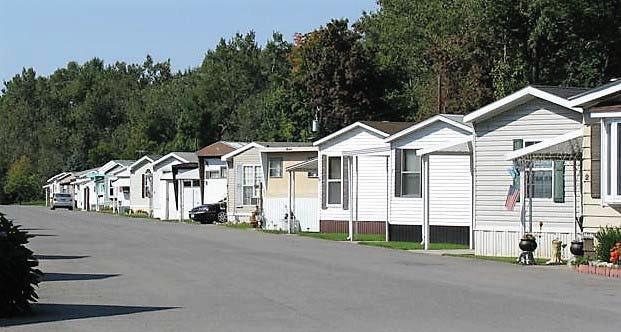


CALL one of our Specialty Agents todayor visit us ONLINE Kurt D Kelley,J.D., President 800-458-4320 www.MobileAgency.com Service@MobileAgency.com You'll understand why we arethe #1 agency for Community Owners once you visit with one of our SpecialtyAgents! Retailers Communities Developers RentalHomes Great Rates Great Value Superior Customer Service
Another Missed Post-Production Opportunity?
HUD Secretary, Dr. Ben Carson, as the saying goes, “gets it.” First, and most fundamentally, he understands – and has very plainly stated -- that to successfully address and ultimately solve the nation’s affordable housing crisis, which has some 21 million American families spending more than one-third of their household income on housing expenses and 11 million of those spending more than half of their income on housing, it is “vitally important … to develop more affordable housing.” Beyond that, he understands (unlike some of his predecessors at HUD) that “the first and most important source” of that much-needed affordable housing, “will always be private enterprise, whether operating independently, or in cooperation with HUD [or] other government initiatives.” And, perhaps most significant of all, he appears to understand what must be done – at HUD – to spur the growth and availability of affordable housing and home ownership from within the private sector and, more specifically, from within the manufactured housing industry that HUD not only comprehensively regulates through its Title VI manufactured housing program, but is also authorized to help finance through programs administered by its Federal Housing Administration (FHA). The question, though, is whether the industry’s post-production sector (i.e., retailers, communities, developers, finance companies, and insurers, among others) “gets it,” and will act to create the type of independent collective representation that will be needed to seize these unparalleled policy opportunities.
By Mark Weiss
In a speech earlier this year to the Policy Advisory Board of the Harvard University Joint Center for Housing Studies, and in a follow-up HUD publication entitled “Regulatory Barriers and Affordable Housing,” Secretary Carson clearly pinpointed the keys to unleashing the enormous potential of the manufactured housing industry to help expand homeownership and fulfill HUD’s essential mission of “ensur[ing] safe, affordable housing for [all] Americans.”
First, Secretary Carson observed that the availability of affordable housing for Americans cannot be achieved “by hindering those who are most responsible for creating it.” He thus emphasized the importance of the current – and ongoing -- regulatory review of the HUD manufactured housing program being conducted under Trump Administration Executive Orders 13771 (“Reducing Regulation and Controlling Regulatory Costs”) and 13777 (“Enforcing the Regulatory Reform Agenda”). MHARR, for its part, has strongly supported and encouraged this long-overdue review of HUD regulations and other pseudo-regulatory actions taken in violation of applicable law, and has submitted extensive comments detailing various aspects of the HUD manufactured home regulatory structure that must be changed, not only to achieve the regulatory reform agenda of President Trump, but also to achieve the overriding objective of the Manufactured Housing Improvement Act of 2000 – i.e., “to facilitate the availability of affordable manufactured homes and to increase homeownership for all Americans.”
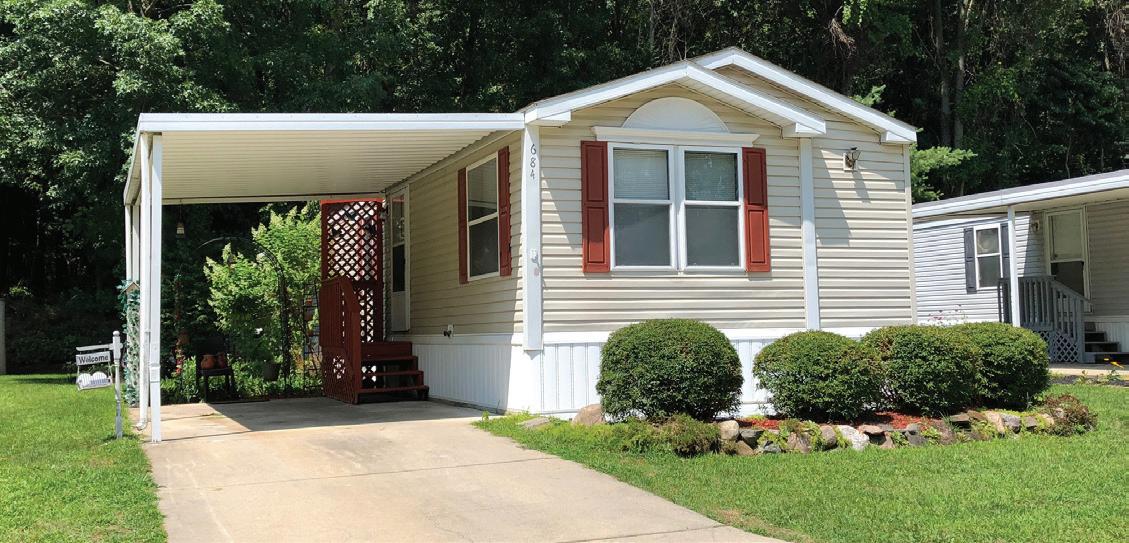
April 2018 ISSUE • 281.460.8384 • ManufacturedHousingReview.com - 11 -
Another Missed Post-Production Opportunity? Cont.
Significantly, though – and as important as that regulatory review and reform process is – Secretary Carson did not stop there.
Instead, he went on to address two other key issues (repeatedly stressed and explained in detail by MHARR to HUD officials and other government decision-makers for years) that have played a crucial role in suppressing the availability of the inherently affordable homeownership sought and needed by moderate and lower-income Americans and provided by America’s manufactured housing industry. Both of these matters, as emphasized by Secretary Carson -- and as previously emphasized by MHARR -- need to be confronted and resolved in order to revitalize and expand the availability of affordable HUD Code manufactured homes in marketsignificant numbers for the millions of American families in urgent need of affordable housing, and also to comply with the law and policy choices already made by Congress in the 2000 reform law.
These issues – and the corresponding actions needed by HUD to address and resolve them, as stressed and emphasized by Secretary Carson -- are: (1) action to eliminate the discriminatory exclusion of manufactured homes and manufactured home communities by local governments; and (2) the need to significantly expand the availability of consumer financing for HUD-regulated manufactured homes through both FHA and the HUD-affiliated Government National Mortgage Association (GNMA) (in addition to the establishment of comprehensive and market-significant HUD Code consumer finance programs by Fannie Mae and Freddie Mac, which currently do not exist).
Regarding the discriminatory exclusion of manufactured homes from many areas and communities around the nation, Dr. Carson stated in his Harvard speech: “We are also [acting] to identify and incentivize the tearing-down of local regulations that serve as impediments to the developing affordable housing stock. Out-of-date building codes, time consuming approval processes, restrictive or exclusionary zoning ordinances, unnecessary fees or taxes, and excessive land development standards can all contribute to higher housing costs and production delays.” (Emphasis added). Moreover, the direct and significant correlation between the discriminatory exclusion of manufactured homes, inflated housing prices and the economically and socially-detrimental unavailability of affordable housing is explained and addressed in HUD’s “Regulatory Barriers and Affordable Housing” publication, which states, in part: “Evidence supports the contention that zoning and land use
regulations increase housing prices. *** Zoning that excludes manufactured housing … contributes to affordability challenges, because manufactured housing potentially offers a more affordable alternative to traditionally-built housing without compromising building safety and quality.”
It is thus evident that both Secretary Carson -- and the Trump Administration political leadership at HUD generally -recognize that the discriminatory exclusion of manufactured homes from large swaths of the country by local governments is not only bad for the industry, but bad for Americans, bad for the American economy, bad for the availability of affordable housing and, ultimately, bad for the nation as a whole. The next question, then, is whether, having recognized the unequivocally-detrimental impact of this sort of discriminatory exclusion, Secretary Carson, President Trump, the political leadership at HUD and within the Administration more broadly, is willing to take the next logical step to end that discrimination – via a tool provided in the 2000 reform law, that is specifically designed for that very purpose.
Specifically, as MHARR has written (see, the December 2015 and January 2016 editions of MHARR Viewpoint, “Combating Discriminatory Exclusion” – Parts One and Two) – and as key congressional proponents of the 2000 reform law noted shortly after the law’s enactment – the enhanced federal preemption of the 2000 reform law provides, and was intended by Congress, to provide HUD with all the authority it needs to preempt, invalidate and supersede local zoning and land use ordinances that discriminate against HUD Code manufactured housing. Thus, in a November 13, 2003 communication to HUD, those Congressional proponents of the 2000 law stated:
“The 2000 Act expressly provides, for the first time, for preemption [to] be ‘broadly and liberally construed’ to ensure that local ‘requirements’ do not affect ‘federal superintendence of the manufactured housing industry.’ Combined with the expansion of the findings and purposes of the Act to include for the first time {facilitating the ‘availability of affordable manufactured homes’ … these … changes give HUD the legal authority to preempt local requirements or restrictions which discriminate against the siting of manufactured homes … simply because they are HUD Code homes.”
(Emphasis added).
Given that HUD – through its most senior official -- has now fully and expressly acknowledged and recognized the extremely
April 2018 ISSUE • 281.460.8384 • ManufacturedHousingReview.com - 12 -
Another Missed Post-Production Opportunity? Cont.
debilitating impact of local enactments that discriminatorily exclude HUD-regulated manufactured homes from entire communities, with cumulative impacts that needlessly and unlawfully deprive millions of Americans of affordable housing and homeownership opportunities, HUD should –and indeed, must, make use of the remedy specifically and purposefully provided to it by the 2000 reform law, and adopt a policy that preempts local laws which discriminatorily exclude manufactured homes.
Beyond this, in the finance arena, the affordable homeownership provided by manufactured homes is an empty promise for millions of otherwise qualified Americans, without available consumer financing, as Secretary Carson recognized in his Harvard speech, stating: “[O]ne of the best things we can do to help creditworthy borrowers obtain mortgage credit is to provide certainty to the market …. *** [B]ecause of our fundamental housing mission, FHA mortgage insurance program and Ginnie Mae mortgagebacked security guarantees are large and vital components of the housing finance system, HUD will be an active participant in this critical dialogue.”
Based, in part, on this recognition by the Secretary and the Trump Administration, MHARR, in its recent meeting with Federal Housing Commissioner, Brian Montgomery, called for a revitalization of the FHA Title I manufactured housing program, which used to be an important source of the chattel financing which supports 80%, or more, of the manufactured housing market, but has fallen to negligible numbers over the past decade due, in large measure, to the GNMA 10-10 rule, which severely and needlessly restricts lender participation in that program (to currently just two lenders which are both subsidiaries of Clayton Homes, Inc. and Berkshire Hathaway, Inc.). In part, MHARR called for a fundamental re-examination of the 10-10 rule and its alleged bases and justifications, to provide an alternative source of market-significant securitization support for manufactured home chattel loans in view of the failure of Fannie Mae, Freddie Mac and the Federal Housing Finance Agency (FHFA) to implement the “Duty to Serve Underserved Markets” (DTS) mandate in a way that would provide such support to this vital component of the manufactured housing consumer finance market. And with both a new FHA Commissioner and a new GNMA President appointed by President Trump now in place in their respective positions, there is no time like the present to push hard for changes to revitalize the Title I program in particular.

History shows, however, that neither HUD nor any other component of government will simply “give” the industry what it wants – and what would ultimately be beneficial for millions of mostly moderate and lower-income Americans. Instead, the industry needs to fight aggressively for the government policies and actions that are essential to its growth and expansion, and to the fulfillment of the fundamental objective of established law – to “facilitate the availability of affordable manufactured housing” for all Americans. And, while the public record, as demonstrated above, strongly suggests that aggressive industry advocacy, right now, could have a significant impact in changing a decade of failed and damaging policies, a fundamental and, indeed, necessary component of that advocacy – a collective national voice and representation for the industry’s post-production sector – where these specific problems exist and cause the most damage, is currently absent.
As MHARR has emphasized before, conducting meetings, conferences, seminars and other similar gabfests will not change government policies in Washington, D.C. – especially ones that have been in place for years or even decades (like the under-utilization of federal preemption authority to clear away discriminatory exclusion enactments). What is needed is strong, focused, aggressive, collective and most-importantly, independent advocacy on behalf of the thousands of smaller businesses that constitute the core of the industry’s post-production sector, whose interests today are, more often than not, sacrificed to the industry’s largest corporate conglomerates.
The opportunity for real change and for real growth in both the near and long-term, clearly exists. The question is whether that opportunity will be seized and maximized where it counts the most.
MHARR is a Washington, D.C.-based national trade association representing the views and interests of independent producers of federallyregulated manufactured housing.
“MHARR-Issues and Perspectives” is available for re-publication in full (i.e., without alteration or substantive modification) without further permission and with proper attribution to MHARR.
April 2018 ISSUE • 281.460.8384 • ManufacturedHousingReview.com - 13 -
Capital CASH provides capital to purchase new homes including setup expenses. No money out of pocket - no payments for 12 months. Fill your vacant sites with no capital of your own.
Consumer Financing (NEW AND USED) Affordable consumer financing with 12-23 year terms is available for all credit scores on homes you own in your community. We offer financing options for 1976 homes and newer with a minimum loan amount of $10,000.

Rental Home Program Is your customer not quite ready to own their home? No problem, 21st will finance the rental home to your community, while offering you a low down payment, low interest rate, and a 10-15 year term.
Marketing Support We supply marketing materials for your community at no cost. Our staff will also consult with your team on effective marketing strategies for your community.
Customer Lending Support A dedicated 21st Mortgage MLO (Mortgage Loan Originator) is provided to assist customers through every step of the process.
Contact Us TODAY TO GET STARTED! Have Questions or Need More Information? Speak To A Business Development Manager 844.343.9383 \\ prospect@21stmortgage.com NMLS #2280 This document is not for consumer use. This is not an advertisement to extend consumer credit as defined by Tila Regulation Z. 10/2017 COM
is CASH the best program for your community?
Why
Outlined Outlined Outlined Outlined Outlined
Overt Discrimination Against Manufactured Housing Owners in Odessa, Texas
The Odessa City Council voted unanimously for a first reading of a proposal specifically designed to raise the cost of living in manufactured homes at an August 14th Council Meeting. The proposal will require skirting that is or appears to be brick, poured concrete, wood, or finished metal that matches the exterior of the home. The step requirements are for both the front and the back of the home. They mandate a permanent landing that will have to include wooden accents or a column porch. All step and landings would have to have a roof, too. The testimony during the meeting regarding this issue solely focused on increasing the cost and tax basis of these homes, not once mentioning aesthetic value. Odessa is a working-class energy production city of about 100,000 residents located in West Texas and within the Permian Basin, one of the nation’s most productive oil and gas regions.
While there was brief mention at first that these new requirements are also designed to improve the aesthetic appeal of manufactured homes, the discussion by the council members was strictly limited to imposing the new requirements in order to increase the local tax base. City Councilman Malcolm Hamilton expressed that the city is missing out on property tax revenue by allowing manufactured homes in the city versus only allowing admittedly more expensive “slab concrete stick-built” homes. The Councilman requested a report from the staff that would show the “amount of tax revenue the city is missing out on” by allowing manufactured homes within the city limits. The City Manager agreed to prepare such a report.
By Della Holland
There was no discussion of what value manufactured home would be compared to what value site-built home. There was also no discussion about the practicality of moving thousands of working families from manufactured homes into quarter million-dollar site-built homes. None of the council members mentioned tax revenue foregone due to homestead exemptions or those over 65 with frozen property tax amounts. And as a final bit of only-the-government-woulddo-this absurdity, the council voted that same evening to hire a consultant for $73,000 to help with the local affordable housing crisis.
Manufactured homes are a favored housing choice in Odessa. Records reflect that in 2017, there were 324 new manufactured homes installed within the city. The Odessa City Council meets every second and fourth Tuesday at 6 pm on the 5th floor of City Hall at 411 W. 8th Street.
By Della Holland, Writer, Manufactured Housing Review with special input from the Executive Director of the Texas Manufactured Housing Association, DJ Pendleton and his staff.
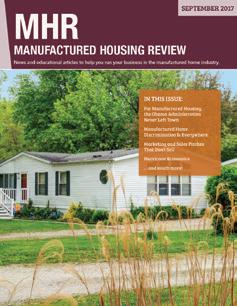
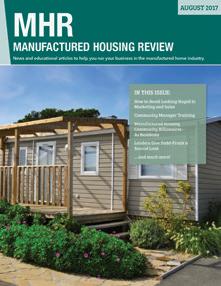
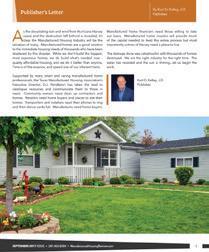
April 2018 ISSUE • 281.460.8384 • ManufacturedHousingReview.com - 15To join, Contact Ms. Della Holland at 281-367-9266, ext. 110 or email at Staff@ManufacturedHousingReview.com Special Advertising rates are available for all six month or more campaigns.
JOIN THE MANUFACTURED HOUSING REVIEW AS AN ADVERTISER
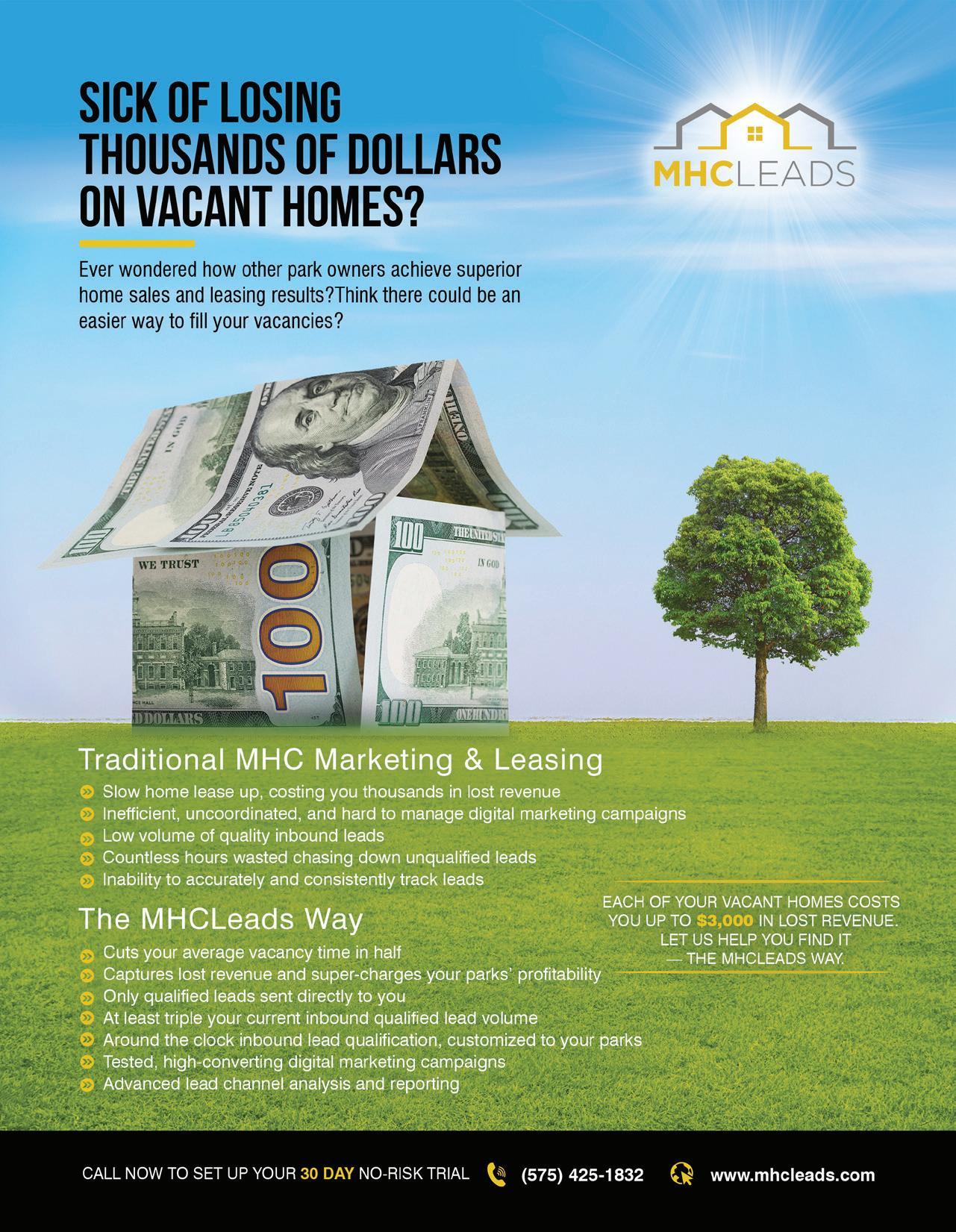
Evaluating Your Investments
Business owners are restless when it comes to the topic of retirement planning. Are you ahead or behind schedule when it comes to saving for retirement and are you saving enough?
In his book Your Money Ratio$, Charles Farrell attempts to answer this question with the capital-to-income ratio (CIR) The CIR assumes that if you have capital worth about 12 times your gross annual income at age 65, you should be able to live on about 80% of your preretirement income.
To calculate your CIR, add up your retirement assets, including your savings, 401(k) plans, IRAs, annuities and CDs, the cash value of your life insurance, the money you have set aside in any other savings accounts, equity in commercial real estate (not your primary residence), and the fair market value of any business interests.
These types of schedules make a lot of business owners nervous for several reasons.
First, many owners liquidate their entire savings just to start their businesses. During the early years, survival is the goal. There is no paycheck or 401(k) and saving for retirement is of low priority. After survival is assured, owners are behind in saving for retirement.
Second, most owners will rely upon selling their business to fund their retirement, but many have unrealistic expectations.
By Austin Lewis
I find that owners overestimate the value of their business. When I was a transactional attorney, I learned that a business is never worth more than a qualified buyer is willing to pay, and the number of qualified buyers can vary dramatically depending upon business conditions at the time.
Business owners are justly proud of the blood, sweat, tears and treasure they have invested in their business. But don’t let this pride seduce you into an unrealistic valuation. Be realistic, objective, and flexible.
In my line of work, the value of advisory firm usually starts around a multiple of two times earnings. Recently I was approached by the owner of a firm based in Mississippi who told me he would be willing to sell me his firm for a multiple of nine times earnings. When I asked him what justified that kind of price, he was defiant, but very vague. I could tell he had fallen in love with a valuation number, which was probably what he needed to fund the retirement he wanted. He simply backed into the multiple.
Family businesses have special challenges. I talked to an owner of a business that he founded over 30 years ago. He told me that his business was worth $3 million. When I asked him how he calculated that number, he said it “sounded about right.” After a couple of years, he was unable to find a qualified buyer at that price. Health concerns accelerated his retirement. His son wants to take over the business, but every time he leaves him in charge while he is out of town, he comes back to angry customers, disgruntled employees, and questionable bookkeeping transactions. Even if his son was capable of running the business, he does not have the resources to pay the purchase price nor could he qualify to get financing for the transaction. He does not want to break the news to his son, but he’s quietly scrambling to liquidate his business for a lot less so he can retire
I met another owner who wants to retire in the next 5 years. He believes he can hire someone to run his business while he comes by the office every week or so to pick up his “mailbox money” that will fund his retirement. He’s running into two problems. First, he cannot find someone talented enough to take his place that he can afford and who does not want a piece of the action. Second, he does not know how he will unlock all of his equity at some point in the future.
Plan for the future. Give a great deal of thought about how you will be converting your business equity into a retirement asset. Get an objective opinion about the value of your business from a qualified broker or valuation expert, even if you are not
April 2018 ISSUE • 281.460.8384 • ManufacturedHousingReview.com - 17 -
Your Age Capital-to-Income Ratio (the multiple of your annual income you should have accumulated) 25 0.1 30 0.6 35 1.4 40 2.4 45 3.7 50 5.2 55 7.1 60 9.4 65 12.0
Evaluating Your Investments Cont.
selling your business any time soon. What kind of metrics are important to calculate the value of your business? Would it be wise to tailor your operations around these metrics? What kind of due diligence would a potential buyer seek? Can you structure your record keeping around this due diligence? How does your business really measure up to others in your industry? Where are you ahead, and where are you behind? Don’t forget about taxes – they will consume a surprising percentage of your sale price.
Talk to other owners about the sale of their business and what they learned from the transaction. Talk with an accountant and an attorney about how to structure the sale of your business to maximize the price while minimizing taxes. Talk with a financial planner about how much you really need to retire. This will help you be realistic when it comes to the sale of your business. Planning for this transaction can take years. To get the most for your business equity and your retirement, start working towards these goals now.
Right now, you should do whatever you can to fund whatever retirement vehicles you can currently use (e.g. 401(k)s, SEPs, IRAs, etc.). Save as much as you can. This will take pressure off the eventual sale of your business. Avoid making your entire retirement security dependent upon the sale of your business.
If you have questions or concerns about your situation, please give us a call at (855) 353-3800.
Austin Lewis is a wealth manager at Lewis Wealth Management, a firm he founded in 2010. He focuses on providing wealth management solutions to a select number of affluent clients in a boutique setting. He is a CERTIFIED FINANCIAL PLANNER professional.

Austin has over 25 years of experience in advising clients as a banker, attorney, and financial advisor. Austin started his career as a business banking officer with Wells Fargo Bank. Upon graduation from law school, Austin practiced law for nine years at two prestigious San Francisco law firms: Gordon & Rees and Craigie, McCarthy & Clow, where he specialized in advising businesses on litigation and transactional matters. When Austin returned home to Colorado in 2001, he served as senior in-house counsel to two Colorado companies: Graphic Packaging and Qwest. Since 2005, he has been advising affluent clients on all their financial matters.
Austin received a B.S. in Business Administration from the University of Colorado in 1986, an M.B.A. from San Francisco State University in 1989, and a law degree from Marquette University in 1992.
Lewis Wealth Management is a fee-only, investment advisory firm based in Greenwood Village, Colorado. www.LewisWM.com.

April 2018 ISSUE • 281.460.8384 • ManufacturedHousingReview.com - 18 -








Titan Titan Xterior Prime is a foundation cover built to withstand the demands of everyday life. Our reinforced panel design resists damage caused by lawn care accidents, playful children, and mother nature. 800.945.4440 www.stylecrestinc.com/titan-xterior Titan Strong. Titan Tough. Titan Xterior. Dove White
Engineered for Strength & Designed for Beauty
Clay
For almost a decade, the Southeast Community Owners Symposium, SECO, has been a non-profit 501(c)3 organization founded and managed by experienced community owners determined to create an annual event which would provide an independent platform for small to mid-sized community owners from all over the country.
During this conference, held Wednesday, October 10th and Thursday October 11th, each attendee has the unique opportunity to meet, mingle and network, through the entire event, developing key contacts and meeting seasoned industry professionals. This conference has been recognized as a “must attend” for those considering involvement in the manufactured housing industry. It’s here you meet and create relationships with experienced knowledgeable operators whose advice and suggestions could save them costly mistakes! Fifty exhibitors and sponsors from the industry will be attending SECO18 making it easy to learn about all the latest products available on the market. There will be over 400 manufactured housing professionals, from over 25 states exploring new ways of managing, new financing options for MH communities, and ways to increase a CO’s bottom line.
The conference consists of the Pre-SECO workshops and the SECO18 conference. Pre-SECO workshops will be on Tuesday October 9th and offer a variety of comprehensive workshops. These workshops are extremely educational and cover current topics central to community owners, investors and property managers.
• Renting MHs Instead of Selling
• Social Media Bootcamp
• Passive Investing in MHPs
• Valuation of MHPs
• Self-Storage
• Technology in Communities
• RV Parks
• Community Liability Issues
• Service and Emotional Support Animals
• Emergency Preparedness
• Storm Shelters
• Demonstration - Installing New Homes in Your Community
SECO18, a series of up-to-the-minute presentations from experts in the manufactured housing industry. Also, an interactive panel discussion on key topics and issues and Wednesday evening, a round table event which provides an opportunity for indepth and specific questions.
Here are a few of the subjects to be presented:
• 5 Keys to Bringing New MHs Into Your Community
• Succession - Future of Your Business
• Internet Marketing Trends and Tactics
• How Much is Your Community Worth in Today’s Market?
• Opening the Cash Vault - Community Acquisition and Refinancing
• Financing Mobile Homes
Registration to SECO18 includes the presentations, coffee breaks, lunches and a reception with the option of adding the Pre-SECO workshops. Visit their website www.SECOConference.com for more information and to register. I promise you will not be disappointed.
Kurt D. Kelley, J.D.

April 2018 ISSUE • 281.460.8384 • ManufacturedHousingReview.com - 20 -
SECO, now the largest MH Industry event for Small to Mid-Sized Community Owners and Property Managers in the country!
SECO is designed and delivered by, and for, small & midsize community owners & management/sales personnel. Learn the latest regarding successful community management as well as buying, financing, marketing, and selling MHs through educational workshops, informative presentations and panel discussions by your peers







Pre- SECO Workshops –
The Premier Conference for Owning and Managing Successful Manufactured Home Communities 9th Annual Conference NEW LOCATION FOR 2018 Atlanta Airport Marriott 4711 Best Road, Atlanta GA (800) 228-9290 Reserve Now ! We have a limited number of rooms available at the low SECO rate of $144/night Attendance is limited to 400. Don’t wait! 50 Sponsors & Exhibitors
Visit www.SECOConference.com to register SECO18 For Community Owners, By Community Owners
George Allen’s MHM Class – Monday October 8,2018
Tuesday October 9 SECO – Wednesday October 10 - Thursday October 11
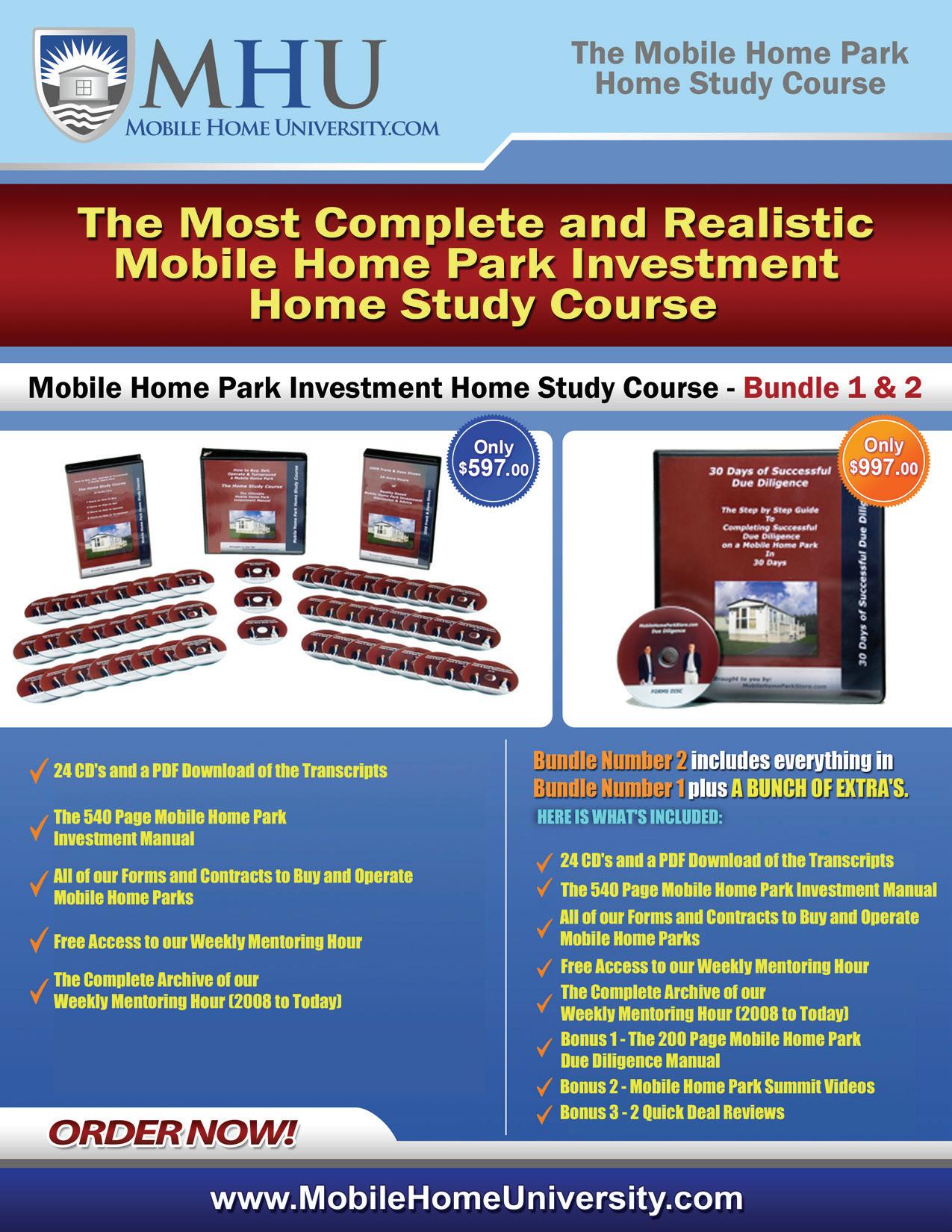
MHR MANUFACTURED HOUSING REVIEW We are an electronically delivered monthly magazine focused on the Manufactured Housing Industry. From Manufactured Home Community Managers, to Retailers, to Manufacturers, and all those that supply and service them, we supply news and educational articles that help them run their businesses. 281.460.8384 ManufacturedHousingReview.com Communications regarding any alleged offending, inappropriate, inaccurate or infringing content should be directed immediately to kkelley@manufacturedhousingreview.com along with the communicator’s contact information. Have something to contribute or advertise? Email us at staff@manufacturedhousingreview.com




 Kurt D. Kelley, J.D. Publisher kkelley@manufacturedhousingreview.com
Kurt D. Kelley, J.D. Publisher kkelley@manufacturedhousingreview.com



































